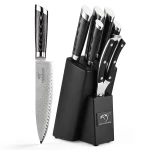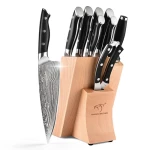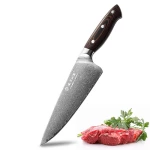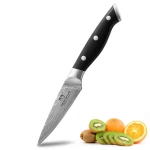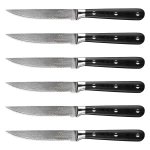What are the Different Types of Chef's Knives? From Classic German to Japanese Carbon Stee

Chef's knives come in various types, each with its own design, blade shape, and intended use. Here are some of the most common types
1. French Chef's Knife (or Chef's Knife)
Blade Shape: Wide, gradually curved blade with a pointed tip.
Purpose: Versatile for chopping, slicing, dicing, and mincing a wide range of ingredients.
Features: Balanced design for general kitchen tasks.
2. German Chef's Knife:
Blade Shape: Similar to the French chef's knife but with a slightly thicker and heavier blade.
Purpose: Suitable for heavy-duty tasks like breaking down larger cuts of meat and chopping through bones.
Features: Robust and durable design, typically with a full tang and a pronounced bolster for added balance and safety.
3. Japanese Gyuto:
Blade Shape: Thinner and lighter than Western chef's knives, with a more pronounced taper towards the tip.
Purpose: Multipurpose knife suitable for precise slicing, dicing, and chopping of vegetables, meat, and fish.
Features: Often made from high-carbon steel for exceptional sharpness and edge retention. Ideal for precise, intricate cuts.
4. Santoku Knife:
Blade Shape: Shorter and wider blade with a flat edge and a low tip.
Purpose: Primarily used for slicing, dicing, and chopping fruits, vegetables, and boneless meats.
Features: Versatile knife with a flat cutting edge, making it suitable for precise, downward cuts.
5. Nakiri Knife:
Blade Shape: Rectangular-shaped blade with a straight edge and a squared-off tip.
Purpose: Designed specifically for slicing, dicing, and chopping vegetables with a push-cut motion.
Features: Thin, double-beveled blade with a flat edge, ideal for processing large quantities of vegetables quickly and efficiently.
6. Japanese Deba:
Blade Shape: Thick, single-beveled blade with a curved edge and a pointed tip.
Purpose: Traditional Japanese knife for butchering and filleting fish, poultry, and other meats.
Features: Robust construction for heavy-duty tasks, with a single bevel suitable for precise, controlled cuts.
7. Japanese Usuba:
Blade Shape: Thin, rectangular-shaped blade with a straight edge and a squared-off tip.
Purpose: Specialized knife for slicing and chopping vegetables with a push-cut motion.
Features: Single-beveled blade with a flat cutting edge, allowing for precise, clean cuts and thin slices.
8. Japanese Yanagiba:
Blade Shape: Long, thin blade with a single bevel and a pointed tip.
Purpose: Primarily used for slicing raw fish for sushi and sashimi.
Features: Extremely sharp, single-beveled blade designed for precise, delicate cuts to maintain the integrity of the fish.
Each type of chef's knife has its own advantages and is suited to different cooking styles, techniques, and ingredients. Choosing the right knife depends on personal preference, culinary expertise, and the specific tasks you perform in the kitchen.

